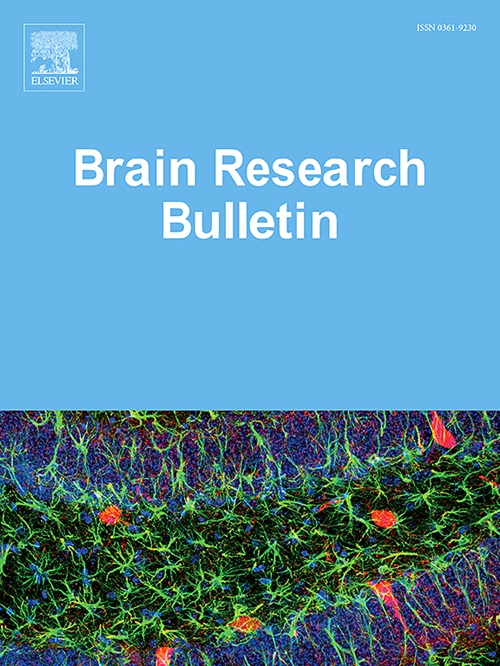通过HIF-1α-ET-1/eNOS途径增强缺血皮层的再灌注,奥列克辛A可保护脑缺血再灌注损伤。
IF 3.7
3区 医学
Q2 NEUROSCIENCES
引用次数: 0
摘要
本研究旨在探讨奥曲肽 A 对脑缺血再灌注损伤的保护作用及其机制,特别是通过缺氧诱导因子-1α(HIF-1α)-内皮素-1(ET-1)/内皮一氧化氮合酶(eNOS)通路介导的血管扩张作用。在外源性奥曲肽 A 干预的野生型 SD 大鼠和奥曲肽 A 转基因大鼠中建立了大脑中动脉闭塞模型。评估了神经功能缺损评分和脑梗塞面积,并监测了缺血皮层血流量。采用实时 RT-qPCR 和 Western 印迹分析法分别检测了 HIF-1α、HIF-2α、ET-1 和三种 NOS 的基因和蛋白表达水平。此外,还通过生化检测方法分析了大脑皮层中的一氧化氮(NO)水平。通过在再灌注过程中增加大脑皮层血流量,奥列克辛 A 显示出减少脑梗塞和改善神经功能缺损的保护作用。这种保护机制与 HIF-1α 表达上调、ET-1 表达下调、eNOS 表达上调和 NO 生成增加有关。这项研究证明了奥曲肽 A 对脑缺血再灌注损伤的保护作用,这种作用是通过调节血管运动物质的释放来实现的,从而增强再灌注过程中大脑皮层的血流量。这些发现表明,奥曲肽 A 可能是缺血性中风的一种潜在治疗策略。本文章由计算机程序翻译,如有差异,请以英文原文为准。
Orexin A protects against cerebral ischemia-reperfusion injury by enhancing reperfusion in ischemic cortex via HIF-1α-ET-1/eNOS pathway
The purpose of this study was to investigate the protective effect and underlying mechanism of orexin A on cerebral ischemia-reperfusion injury, specifically through vasodilation mediated by the hypoxia inducible factor-1α (HIF-1α)-Endothelin-1(ET-1)/endothelial nitric oxide synthase (eNOS) pathway. A model of middle cerebral artery occlusion was established in both wild-type SD rats with exogenous orexin A intervention and in orexin A transgenic rats. Neurological deficit scores and cerebral infarction areas were assessed, and ischemic cortical blood flow was monitored. Gene and protein expression levels of HIF-1α, HIF-2α, ET-1, and three types of NOS were detected using real-time RT-qPCR and Western blot analysis, respectively. Additionally, nitric oxide (NO) levels in the cortex were analyzed through biochemical detection methods. Orexin A demonstrated a protective effect by reducing cerebral infarction and improving neurological deficits, which was achieved by increasing cortical blood flow during reperfusion. This protective mechanism was associated with upregulated HIF-1α expression, downregulated ET-1 expression, upregulated eNOS expression, and increased NO production. This study demonstrates the protective effect of orexin A on cerebral ischemia-reperfusion injury, achieved by regulating the release of vasomotor substances to enhance cortical blood flow during reperfusion. These findings suggest that orexin A may represent a potential therapeutic strategy for ischemic stroke.
求助全文
通过发布文献求助,成功后即可免费获取论文全文。
去求助
来源期刊

Brain Research Bulletin
医学-神经科学
CiteScore
6.90
自引率
2.60%
发文量
253
审稿时长
67 days
期刊介绍:
The Brain Research Bulletin (BRB) aims to publish novel work that advances our knowledge of molecular and cellular mechanisms that underlie neural network properties associated with behavior, cognition and other brain functions during neurodevelopment and in the adult. Although clinical research is out of the Journal''s scope, the BRB also aims to publish translation research that provides insight into biological mechanisms and processes associated with neurodegeneration mechanisms, neurological diseases and neuropsychiatric disorders. The Journal is especially interested in research using novel methodologies, such as optogenetics, multielectrode array recordings and life imaging in wild-type and genetically-modified animal models, with the goal to advance our understanding of how neurons, glia and networks function in vivo.
 求助内容:
求助内容: 应助结果提醒方式:
应助结果提醒方式:


